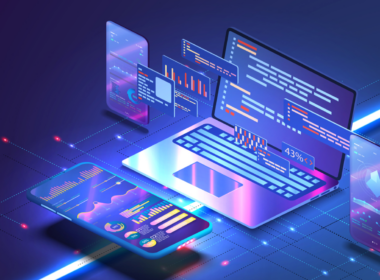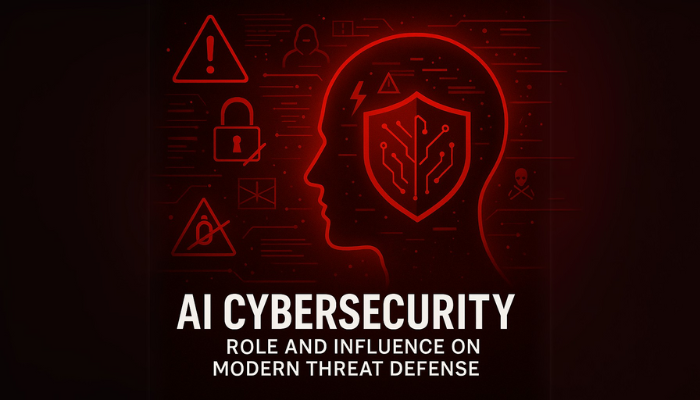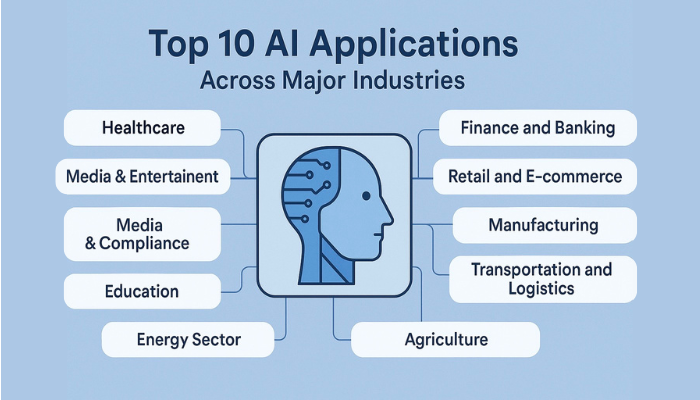Cybercriminals aren’t just hoodie-wearing hackers anymore. They’re using AI to build smarter malware, generate deepfakes to impersonate CEOs, and craft phishing emails that are almost indistinguishable from real communication. And they’re not doing it on a small scale, they’re automating attacks to reach thousands, even millions, in minutes.
Infact, the cost of cybercrime is expected to soar by 69.4% over the next five years, reaching a staggering $15.63 trillion by 2029.
Now, picture this: your traditional security tools are still checking for known threats like it’s 2012. Signature-based systems and static firewalls aren’t built to handle shapeshifting malware or zero-day exploits. But AI cybersecurity is. It doesn’t wait to be told what a threat looks like: it learns, adapts, and acts faster than any human team ever could.
In this blog, we’re unpacking how AI and cybersecurity are now inseparable. You’ll get a front-row seat to real use cases, smart tools, and the latest developments in cybersecurity AI, plus how Codewave helps businesses like yours go from reactive to resilient. Let’s get into it.
What Is AI Cybersecurity and Why Should You Care?
Let’s break it down. AI cybersecurity is simply the use of artificial intelligence to defend systems, networks, and data from cyberattacks. But unlike traditional security tools that follow pre-set rules, AI can actually think for itself, well, almost. It learns from patterns, spots weird behavior, and acts before a threat blows up into something bigger.
Let’s simplify it:
- A standard firewall might block known malicious IPs.
- But what if the attack comes cloaked in clean credentials and polished language?
- AI connects the dots: a strange login time, an offbeat data transfer, or a user acting out of character, and raises the alarm immediately.
Why Traditional Cybersecurity Just Can’t Keep Up
- Signature-based systems rely on known threat patterns. But today’s malware mutates too fast, making those signatures obsolete within hours.
- Manual threat hunting? Not scalable. There are now over 450,000 new malware samples released every single day.
- Human analysts simply can’t review every alert or investigate every suspicious login. Fatigue and false positives are now common, letting real threats slip through the cracks.
Take phishing. A decade ago, it was easy to catch. Misspelled names, broken formatting, and shady links. Today, attackers use AI to create flawless, personalized emails that mimic your CEO’s tone. AI cybersecurity systems don’t fall for the surface, they analyze context, behavior, and timing to detect threats hiding in plain sight.
The Evolution of Cyber Threats
If you’re still picturing viruses from USB drives or spammy pop-ups, it’s time for an update. Threats have matured, and they’ve gotten much harder to spot.
1. From Malware to Advanced Persistent Threats (APTs)
- Early cyberattacks were one-off events: viruses, worms, or trojans with simple goals like deleting files or stealing passwords.
- Today, attackers use Advanced Persistent Threats (APTs), stealthy, long-term campaigns designed to stay hidden, move laterally across networks, and quietly siphon off data.
- These threats don’t crash your system overnight. They learn your behavior, mimic it, and attack at the worst possible moment, often months after the initial breach.
- Add to that zero-day vulnerabilities (unknown to software vendors) and polymorphic malware (which constantly changes its code to evade detection), and you’ve got threats that can easily slip past traditional tools.
2. Why AI Isn’t Optional Anymore
- You need something that scales with the problem. AI fits that role.
- It doesn’t wait for a threat to be named. It detects anomalies, finds relationships across multiple data points, and responds in seconds.
- Think of AI as your 24/7 security analyst, never sleeping, always learning, and constantly sharpening its defenses with every new signal.
With traditional defenses falling short, it’s time to understand how AI-powered solutions are reshaping the future of cybersecurity.
How AI Actively Defends Your Systems
AI isn’t just scanning threats in the background, it’s actively protecting systems, guiding responses, and predicting attacks before they land. Below are the most impactful, real-world applications of AI in cybersecurity that businesses are already leveraging today.
1. AI-Powered Threat Detection
Traditional security tools rely on fixed rules and known attack patterns. This means they can miss new or unknown threats. In contrast, AI anticipates them.
- Machine learning algorithms can spot strange behavior in your systems, whether it’s an unusual file access, a login attempt from an odd location, or a process that’s slightly off.
- These tools constantly learn from past data and adapt as new threat vectors emerge.
- AI flags suspicious activity before it becomes an incident, shortening the detection and response cycle.
Instead of waiting for security teams to notice an alert, AI highlights what actually matters, fast. That kind of focus makes all the difference when every second counts.
2. Automating Incident Response
Modern security systems can now respond to threats automatically, without waiting for manual action.
- AI-based tools automatically isolate compromised endpoints and block suspicious IPs in real time.
- Repetitive tasks; like log analysis, data correlation, and even ticket creation, are handled without human intervention.
- With orchestration tools powered by AI, your systems can respond to threats collaboratively and instantly.
That means your analysts can finally focus on root causes and strategic planning instead of spending hours sifting through low-priority events.
3. Network Traffic Monitoring
Modern systems continuously track how data flows across networks and connected devices, establishing a baseline of normal activity.
- AI monitors millions of interactions across devices and applications, mapping the expected flow of traffic.
- It quickly identifies odd spikes, lateral movement, or unusual device communications.
- Especially in environments filled with IoT devices, AI acts like a digital gatekeeper. Watching who’s connecting, when, and why.
This context-aware monitoring makes it possible to lock down your environment without slowing it down.
4. Smarter Vulnerability Management
Your team doesn’t need another list of vulnerabilities. It needs to know which ones actually pose a risk.
- AI tools analyze how vulnerabilities are exploited in the wild and help prioritize based on potential impact and exposure.
- These systems connect the dots between missing patches, misconfigurations, and live threat intel.
- Some even recommend or automate patching and hardening actions, removing the lag between discovery and remediation.
You’re not just patching blindly, you’re strengthening defenses with intent.
5. Email Security
Phishing attacks are increasingly difficult to detect because emails now look highly convincing, often mimicking trusted sources like your CFO or internal colleagues.
- AI analyzes sender behavior, content tone, and communication timing, not just subject lines or attachments.
- Even when attackers mimic internal conversations or clone trusted domains, AI sees the hidden signs.
- This reduces reliance on employee judgment and cuts down on risky clicks and compromised credentials.
Your inbox becomes less of a liability, and more of a secure channel.
6. Insider Threat Prevention
Sometimes, the threat is already inside. AI doesn’t assume, it validates.
- By tracking behavior patterns across time, AI identifies when a user deviates from their norm.
- It’s not just about catching malicious intent; it’s about spotting compromised credentials, misuse, or accidental leaks.
- You get alerts that are behavior-based, not rule-based, giving you the context to act with clarity.
Trust is important, but in cybersecurity, visibility is better.
7. AI-Driven Deception and Honeypots
When attackers try to breach a system, they might not realize they’re interacting with fake parts of the network.
- AI creates decoy environments, fake databases, admin panels, and credentials, designed to attract malicious actors.
- Once engaged, the system logs every move: commands executed, tools used, and attack paths taken.
- AI instantly isolates the activity, flags the threat as high-risk, and auto-generates incident reports with full attacker behavior maps.
This turns your perimeter into an intelligence-gathering system, wasting the attacker’s time and giving your team actionable threat telemetry.
8. Continuous AI-Powered Red Teaming
Most security tests are done occasionally, but AI makes testing happen all the time.
- Automated red-teaming tools simulate real-world attack scenarios, credential stuffing, privilege escalation, lateral movement, without waiting for a manual pen test.
- These simulations adapt in real-time based on your system changes: new code pushes, config tweaks, or new asset exposure.
- AI evaluates your defensive response in each case and assigns a risk score with remediation playbooks.
This means you’re not finding flaws months later, you’re pressure-testing your environment every single day.
What’s New in AI-Powered Cyber Defense?
Cybersecurity is no longer just about reacting to threats, it’s now evolving alongside them. AI advancements are changing how attacks happen, how defenses respond, and how security teams approach protection.
A. Generative AI in Cyber Attacks
Hackers now use generative models (like GPT variants) to automatically create more realistic and personalized phishing emails. These emails may look like they came from someone you know, using details gathered from social media.
They also use special software that changes itself every time it infects a system, making it harder for traditional security systems to detect. These new types of attacks require security defenses that can adapt and change, rather than relying on old methods that simply check for known threats.
B. Deepfakes and Synthetic Identities
Cybercriminals are now using AI to create fake voices and faces that look and sound like real people. For example, they can use videos found online to create fake CEO videos for Zoom calls. They also create fake social media profiles to trick identity verification systems that are meant to prevent fraud.
To counter this, businesses need AI that can verify the identity of people by checking things like biometric data (like fingerprints or face recognition), the timing of conversations, and past behavior patterns.
C. Next-Gen Defensive AI Tools
The latest security tools now use AI that learns and adapts over time to find weaknesses in your system. These tools can automatically check your defenses and find gaps that humans might miss.
They also use tricks like creating fake data points (called honeytokens) and adjusting network rules automatically to confuse attackers. Additionally, AI can predict which vulnerabilities are most likely to be attacked, helping security teams focus on protecting the most critical parts of the system.
D. AI in Real-Time Threat Mitigation
AI tools can now instantly detect when an attacker tries to move through your network. Once they find a compromised system, these tools quickly disconnect it and reroute traffic to safer areas.
They also trigger actions that confuse attackers, like creating fake systems to mislead them. This helps limit the time an attacker can stay inside your network, making it harder for them to steal data.
E. AI-Powered Threat Intelligence
Advanced threat intelligence systems use AI to gather information from both inside your network and from external sources like the dark web and open-source data.
The AI then analyzes this information to spot emerging threats, such as a sudden rise in discussions about a new type of attack. You receive alerts that prioritize the most serious threats, along with clear steps to handle them, so you can take action before large-scale attacks occur.
F. AI in Security Operations Centers (SOCs)
In modern Security Operations Centers (SOCs), AI helps by organizing and analyzing raw security data, adding external threat information, and automatically creating summaries of incidents for managers.
AI also suggests immediate actions to take and pushes them into your system to speed up response times. By filtering out irrelevant information and highlighting only the most serious threats, AI helps your security team stay focused on what truly matters, reducing stress and improving efficiency.
Now, let’s dive into a real-world example of how AI is transforming cybersecurity.
Case Study: IBM Watson’s AI Revolution in Cybersecurity
In 2022, IBM’s Watson for Cyber Security redefined how businesses approach cyber threats. By integrating machine learning and natural language processing, Watson could sift through vast amounts of unstructured data, blogs, research papers, and more, at speeds that leave traditional systems in the dust. The results speak for themselves:
- 60% Faster Incident Resolution: Watson cut the time needed to investigate security incidents, speeding up response times dramatically.
- 50x Faster Data Analysis: Unlike human analysts, Watson processed threat data in a fraction of the time, uncovering critical patterns in mere seconds.
- 30% Fewer False Positives: AI-driven insights allowed teams to focus on real threats, reducing irrelevant alerts that usually waste time and resources.
On top of all that, Watson scaled effortlessly. As cyber threats evolve, IBM didn’t need to scale human resources at the same pace, making it an efficient solution for handling growing complexity.
While AI is reshaping cybersecurity, it also brings a set of challenges and ethical dilemmas that can’t be ignored.
AI Cybersecurity Hurdles You Can’t Ignore
With power comes a hidden layer of complexity most teams aren’t prepared for. Before you scale AI, secure it. Before you trust it, understand where it might break.
Let’s look at what’s quietly tripping up even the most advanced AI-driven security systems, and how to fix it.
1. Data Poisoning in Real-Time Logs
Hackers can deliberately add fake information into your security logs, such as system activity logs or network queries. This can trick your AI into learning incorrect patterns, making it easier for attackers to bypass security measures.
Fix it: Instead of using raw, unfiltered logs, always train your AI with clean and verified data. Ensure your security team cross-checks any suspicious data for possible manipulation before using it.
2. AI Output Exposing Sensitive Metadata
Sometimes, AI systems can accidentally reveal sensitive information, like internal server names, user credentials, or private network details, when explaining a potential threat. This can create a security risk by exposing confidential data.
Fix it: Protect sensitive data by masking or replacing it with dummy data before training the AI. Test your system for potential leaks and use privacy measures that limit access to sensitive information, especially when handling user data.
3. Alert Fatigue Due to Unexplainable Triggers
Sometimes, AI systems raise alerts that seem important but don’t explain why. If analysts can’t understand the reason behind an alert, they may ignore it—even if it’s real. This leads to missed threats and wasted effort.
Fix it: Use tools that explain why each alert was triggered. For example, clearly show the data that caused the alert, like repeated failed logins from unusual locations. This helps teams trust and act on AI decisions.
4. Skill Gaps Between Cyber Analysts and ML Teams
Cybersecurity teams and AI (machine learning) teams often speak different languages. Security teams focus on threats and attack methods, while AI teams focus on data and algorithms. If they don’t understand each other, important tools get delayed or built wrong.
Fix it: Encourage both teams to work together in regular meetings or workshops. Clearly define who does what, security teams should set the goals, and AI teams should build the tools to meet them. Collaboration is key.
5. Regulatory Drift & Model Non-Compliance
AI models are often built to meet current security regulations. But if rules change, like updates to NIST or ISO standards, your AI might no longer follow them. This can lead to legal or security problems if you’re not keeping track.
Fix it: Set up a system to regularly check for updates in security rules. Make sure your AI tools are flagged and reviewed whenever there’s a change in compliance requirements, so they stay up to date.
Codewave: AI-Driven Cybersecurity for B2B Enterprises
Security is not a feature, it’s a design decision.
At Codewave, cybersecurity isn’t layered after launch. It’s baked into every phase of digital transformation. Since 2013, we have enabled B2B firms in BFSI, HealthTech, and RetailTech to scale securely, through AI, design thinking, and automation.
- AI/ML-Enabled Threat Detection: We build custom ML pipelines to detect suspicious behavior before it escalates, helping BFSI clients reduce alert fatigue and act on what matters.
- Penetration & Vulnerability Testing: Our automated pentesting framework simulates advanced threat vectors across endpoints, APIs, and cloud infra, crucial for HealthTech and FinTech compliance.
- Cloud Infrastructure Security: From cloud-native microservices to hybrid models, we ensure AWS, Azure, and GCP stacks meet GDPR, HIPAA, and SOC 2 requirements through AI-powered compliance orchestration.
- IoT & Embedded Device Security: For manufacturing and AgriTech, we secure connected ecosystems, building firmware-level defenses against device hijacking and data leaks.
- Blockchain for Secure Data Exchange: Enterprises dealing with sensitive records, especially in logistics and healthcare, leverage our private blockchain frameworks for tamper-proof audit trails.
- Team Augmentation for 24/7 SOC Ops: We integrate specialized AI-security engineers into your team, accelerating detection, response, and remediation within your Security Operations Center.
“Digital trust is earned, line by line, feature by feature.” Let Codewave help you build secure-by-design systems. Talk to our experts and bring AI-powered resilience to your enterprise stack.
Final Say
The future of cybersecurity isn’t just smart, it’s self-aware. AI has pushed cybersecurity from passive defense to proactive resilience. It learns fast, acts faster, and never sleeps. But no algorithm can replace instinct, empathy, or accountability.
True cybersecurity is a partnership, between machine precision and human judgment. Between innovation and ethics. And between risk and responsibility.
That’s why forward-thinking enterprises don’t just adopt AI, they integrate it with intention.
That’s where Codewave steps in, bridging innovation and integrity. With AI-infused cybersecurity, cloud-native design, and compliance-first development, Codewave helps you build systems that defend, adapt, and earn trust.
The threat landscape is evolving. Shouldn’t your defense be too? Talk to Codewave, where security is smart, but always human-first.
Also read: Why AI is Getting Trendy: Key Reasons Behind Its Popularity
Codewave is a UX first design thinking & digital transformation services company, designing & engineering innovative mobile apps, cloud, & edge solutions.







